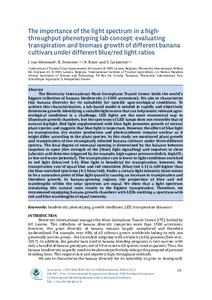| dc.contributor.author | van Wesemael, J. |
| dc.contributor.author | Swennen, R. |
| dc.contributor.author | Roux, N. |
| dc.contributor.author | Carpentier, S.C. |
| dc.date.accessioned | 2020-08-07T13:18:52Z |
| dc.date.available | 2020-08-07T13:18:52Z |
| dc.date.issued | 2020-03 |
| dc.identifier.citation | van Wesemael, J., Swennen, R., Roux, N. & Carpentier, S.C. (2020). The importance of the light spectrum in a high-throughput phenotyping lab concept: evaluating transpiration and biomass growth of different banana cultivars under different blue/red light ratios. Acta Horticulturae, 1272, 13-20. |
| dc.identifier.issn | 0567-7572 |
| dc.identifier.uri | https://hdl.handle.net/20.500.12478/6922 |
| dc.description.abstract | The Bioversity International Musa Germplasm Transit Center holds the world's biggest collection of banana biodiversity (>1500 accessions). We aim to characterize this banana diversity for its suitability for specific agro-ecological conditions. To achieve this characterization, a lab-based model is needed to rapidly and objectively determine growth. Identifying a suitable light source that can help mimic relevant agro-ecological conditions is a challenge. LED lights are the most economical way to illuminate growth chambers, but the spectrum of LED lamps does not resemble that of natural daylight. Red light supplemented with blue light promotes growth of several plant species and suggests that blue light is important. However, the effect of blue light on transpiration, dry matter production and photosynthesis remains unclear as it might differ according to the plant species. In this study, we monitored plant growth and transpiration of two strategically selected banana cultivars under three different spectra. The final degree of stomatal opening is determined by the balance between impulses to open (the strength of the (blue) light signalling) and impulses to close (abscisic acid detection triggered by, for example, high vapour pressure deficit, high CO2 or low soil water potential). The transpiration rate is lower in light conditions enriched in red light (blue/red 1:4). Blue light is beneficial for transpiration; however, the transpiration rate of equal blue and red intensities (blue/red 1:1) is still higher than the blue-enriched spectrum (4:1 blue/red). Under a certain light intensity, there seems to be a saturation point of blue light quantity causing an increase in transpiration and therefore growth. In banana-growing regions, the proportion of blue and red wavelengths within the solar spectrum are equal. We show that a light spectrum simulating this natural ratio results in the highest transpiration. Therefore, we recommend equipping banana growth chambers with LEDs emitting a spectrum with red and blue wavelengths of equal intensity. |
| dc.description.sponsorship | Bioversity international |
| dc.language.iso | en |
| dc.subject | Biodiversity |
| dc.subject | Phenotypes |
| dc.subject | Growth |
| dc.subject | Transpiration |
| dc.subject | Dynamics |
| dc.subject | Agroecology |
| dc.subject | Biomass |
| dc.title | The importance of the light spectrum in a high-throughput phenotyping lab concept: evaluating transpiration and biomass growth of different banana cultivars under different blue/red light ratios |
| dc.type | Journal Article |
| cg.contributor.crp | Agriculture for Nutrition and Health |
| cg.contributor.crp | Roots, Tubers and Bananas |
| cg.contributor.affiliation | Katholieke Universiteit, Leuven |
| cg.contributor.affiliation | International Institute of Tropical Agriculture |
| cg.contributor.affiliation | Bioversity International |
| cg.coverage.region | Asia |
| cg.coverage.region | South Asia |
| cg.coverage.country | India |
| cg.coverage.hub | Eastern Africa Hub |
| cg.researchtheme | Biotech and Plant Breeding |
| cg.identifier.bibtexciteid | VANWESEMAEL:2020 |
| cg.authorship.types | CGIAR and advanced research institute |
| cg.iitasubject | Agronomy |
| cg.iitasubject | Banana |
| cg.iitasubject | Biodiversity |
| cg.iitasubject | Genetic Improvement |
| cg.iitasubject | Plant Breeding |
| cg.iitasubject | Plant Genetic Resources |
| cg.journal | Acta Horticulturae |
| cg.accessibilitystatus | Limited Access |
| cg.reviewstatus | Peer Review |
| cg.usagerightslicense | Copyrighted; all rights reserved |
| cg.targetaudience | Scientists |
| cg.identifier.doi | https://dx.doi.org/10.17660/actahortic.2020.1272.2 |
| cg.iitaauthor.identifier | Rony Swennen: 0000-0002-5258-9043 |

